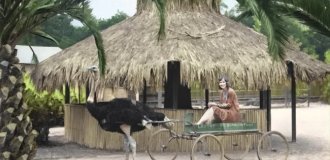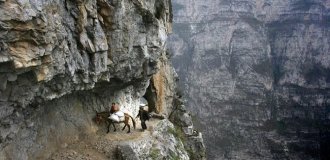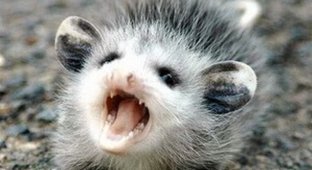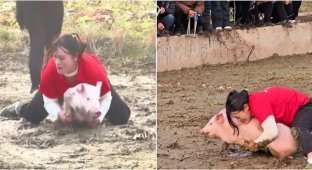Wolverine (in English: Wolverine, in Latin: Gulo gulo)? a predatory mammal that belongs to the mustelidae family. The name of this animal is translated from Latin as “glutton”, and from Norwegian as “mountain whale”.

Wolverine habitats? forest-tundra, taiga, sometimes tundra. They live in North America, Eurasia, and are found in the Baltic states, Poland, and Finland. In Russia, individuals can most often be found in the Far East, in Siberia, but their habitats are also Novgorod, Pskov regions, the Kola Peninsula, and Karelia.

Wolverine? an animal of large size. The body length varies from 70 to 86 cm, and the tail grows to 18–23 cm. The wolverine weighs 9–30 kg, with females slightly smaller than males.
Does Wolverine look like a large badger or a small bear? she has a clumsy, squat body, her hind legs are longer than her front ones. The feet are wide, with a length of 10 cm, they have a width of 9 cm. The muzzle of the animal is elongated, the tail is fluffy.
When walking, the animal steps on the entire foot, so the gait of a wolverine is the same as that of a bear, clubfoot. The wolverine's fur is thick, coarse, and has long hair. The fur is brown-black or brown in color. A golden or yellow stripe runs from the top of the head, along the shoulders, to the croup. The animal's teeth are sharp and powerful.
Are wolverines divided into 2 subspecies? European and North American.

These animals are nocturnal; they sleep during the day and go hunting at dusk.
Wolverines desperately defend the boundaries of their territory if they are violated by an individual of the same sex. They settle in rock crevices, under uprooted tree roots and in other similar places.
They often change their roosting location in search of prey. But at the same time they try not to go beyond the boundaries of their personal plot, which sometimes extends to 2000 square meters. km. Wolverines have excellent hearing, sense of smell, and acute vision. The animal has long claws and powerful paws, so it is easy for it to climb trees.

Since wolverines are predators, their diet mainly consists of animal food. They feed on mouse-like rodents, hazel grouse, black grouse, and sometimes what is left from the hunt of bears and wolves. If the animal has nothing to eat, it can attack the wolf itself (but this happens rarely) or recapture their prey from him or the lynx.
Sometimes wolverines hunt large ungulates; wounded, sick or young animals become their prey. Wolverine can kill an animal that is 5 times taller than itself! But this happens mainly in winter. High snow cover makes it difficult for animals to move; wolverines take advantage of this and attack their potential prey. These predators are able to pursue prey for a long time, as they are distinguished by their endurance.

In summer, wolverine is not averse to eating honey, berries, wasp larvae, bird eggs, and lemmings (rodents). Like the bear, the wolverine fishes during spawning or near wormwood. Moreover, she eats not only fresh fish, but does not disdain already dried fish.
Wolverines hunt birds not only when they are on the ground, but also in nests, since these animals, despite their external clumsiness, perfectly climb trees and cling to trunks and thick branches.
Even a bear tries to avoid an angry and aggressive animal if it meets a wolverine. She can drive the bear away from his own prey and take the trophy for herself.
Although these animals hunt well, they prefer to save energy and, if possible, eat carrion. In this they are also similar to bears.

During the mating season, rassokhas stop leading a solitary lifestyle. The mating season for these animals lasts from April to October, but the most intense breeding season occurs in April? June.
At this time, individuals are intensively looking for a partner. Sometimes animals mate several times in a row. The initial stage of pregnancy in wolverines is very interesting. This period is called the open stage. In almost all other animals, the fertilized egg attaches to the wall of the uterus and begins to rapidly divide and develop here. In wolverines, it moves freely in the uterus for some time without developing. Is it the latent stage that allows wolverine cubs to be born at the most appropriate time of year? in January ? April. This usually happens once every 2 years.
The female is preparing to give birth. To do this, she prepares a long, spacious lair in a hollow tree, under a rock or in a snowdrift, and buries food for herself next to it. Usually 2-3 babies are born, but sometimes up to five. They are born blind, but covered with thick fur, so they do not freeze in the cold, and their mother warms them with her warmth. She extremely rarely leaves the den within 2–3 weeks after giving birth, since during this period she intensively feeds the babies with her milk and protects them. She herself feeds on what she brought as trophies to the den even before giving birth.
After three weeks, she begins to go far to hunt small animals and birds, which she brings to her puppies. When they are 8–10 weeks old, the mother begins to take them out of the den and teaches them to hunt independently.

When deciding to get a wolverine, do not forget that wolverines? quite large predators. It’s even scary to imagine what they can do if a person offends them or behaves in a way that angers the beast.
It is believed that if you take an animal in infancy, it can be tamed. But, of course, wolverines need to be kept in cages and released to roam in a fenced enclosure, observing all safety rules. However, it is better to leave the maintenance and taming of wolverines to professional zoologists who are well aware of all the intricacies of this difficult task, will be able to properly feed the animal and provide the individual with the space necessary for its full life.
Wolverines have another interesting property that makes them difficult to keep at home. Like skunks, when in danger or fear, wolverines can release a foul-smelling stream. Experienced hunters say that if this stream hits hunting dogs, they may lose the sharpness of their senses. If a wolverine marks a person with this secretion, the smell can last up to ten days.
Therefore, it is better to watch this animal from TV screens, in the zoo? this is much safer than deciding to buy an animal for your home.




























